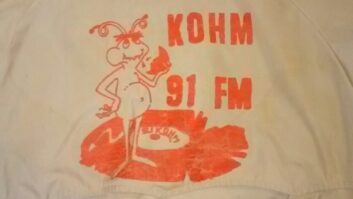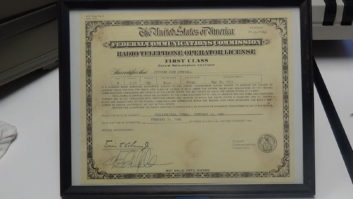A ROYALTY PAIN
The argument over artist royalties has been a battle royale with radio and television broadcasters since the formation of the first musicians’ and actor’s unions and song-publishing powerhouses like ASCAP, BMI and SESAC.
I can’t figure why we haven’t put this entire issue to rest after nearly 100 years and put the burden squarely on the backs of the end consumer, where this issue belongs. We used to do it when record sales were at their peak, and we can still do it today, even though vinyl is not as big as it once was.
Instead of relying on the royalties for airplay from a relative “few” thousand broadcasters, why not get the royalties from the millions of end users who are enjoying the product? Believe you me, we don’t sit around in our offices all day listening to the “sweet” sounds of what we play simply because we like to listen to music all day. We’re running a business, and many of us just play what we’re told to by the chart gurus, not because we like it or enjoy it.
I’ve had the belief for a couple of decades now that we can put the royalty issue to rest simply by implementing an inexpensive royalty fee on all blank media — CDRs, CDRWs, DVDRs, DVDRWs, memory sticks, magnetic tape, any blank media that can hold a file could have a tiny fee attached to it, including the CD/DVD burners and hard drives. Just a penny per blank CD, $5 per memory stick would do the trick and en masse much more revenue than squeezing the turnip blood out of broadcasters. How about gleaning millions of contributors to the “pot” annually, instead of relying on just a few broadcasters? People buy blank media constantly. It would be transparent and not much money to the end consumer and could be collected like a sales tax.
Of course, then, the high-priced lawyers would have nothing much to wrangle broadcasters about if we did it the sensible way, would they?
Also, we could simplify the copyright laws so no one is a criminal any longer for copying something because we would have already paid the royalty through purchase of the blank media. You have to “pay to play” streaming audio or video, so why not put the royalties right in there with it? Put it on the back of the consumer, not the providers of content (broadcasters). Makes too much sense, doesn’t it?
Marvin Walther
Chief Engineer
Carroll Broadcasting
Tawas City, Mich.
FREE RADIO
Responding to “Keep Radio Free and Vibrant,” May 20 issue:
Right now it is a symbiotic relationship, but that only works if both sides recognize the mutual advantages and play fair with each other. I suppose it would be too sarcastic to suggest that radio stations charge music companies to play their music, still …
Tom Dooley
WWSX(LP)
Rehoboth Beach, Del.
BLIND BROADCASTERS
Just a few months ago we purchased a radio station in St. Augustine, Fla., WBHU(FM). As any broadcaster would do we reached out to community leaders for discovery of local needs and wants. Then something unusual happened.
Flagler Broadcasting owner Jim Martin remembered a story in the Dec. 3 issue of Radio World about Monte Sieberns, a blind DJ at WJOT in Wabash, Ind. That story inspired Martin to make a call to the Florida School for the Deaf & Blind in St. Augustine. We were eagerly invited to meet with top school officials, teachers and students.
The campus is comparable to any college with dorms, football field, lake, boats, tennis and auditorium.
At this amazing school there are no handicaps. The blind students easily make there way from class to class. They have a keen sense of today’s technology and all have enthusiasm for bright futures in the business world.
We were told that despite their skills, passion and optimism for the future, statistics say only 20 percent will be employed despite their capabilities, not disabilities.
Many of the students with broadcast and music interests have visited our Beach 105.5 studios. One student sang a station jingle, others will produce commercials and some love telemarketing. In the fall we will have them sell “Don’t Text & Drive” campaigns.
Sometimes the best resources are hidden behind the impossible. At the Florida School for the Deaf & Blind, nothing is impossible.
Thank you, Radio World.
David L. Ayres
Vice President/General Manager
Flagler Broadcasting
St. Augustine, Fla.
COMMUNITY AM WAS HERE FIRST
I am asking the commission to dismiss the rulemaking by REC Networks to allow LPFMs a power increase to 250 watts (“LPFMs Wanna Grow,” radioworld.com). I am the owner/operator of a small AM station near a metropolitan area. I feel that REC Networks is asking for more and more for LPFMs, and before we know it, they will be asking that LPFMs be allowed to be full commercial stations.
The AM revitalization rules that Commissioner Pai and Chairman Wheeler have [proposed] really don’t help stations like mine. My station is a “Class D” daytimer with low-power nighttime authorization that does not cover my community of license, due to a Class A station that was once a Class 1-B Station on my assigned frequency; it is 730 miles from my transmitter site. My station relies on revenue to stay on the air and serve the public. We AMs were here first, and a vast majority of these stations are locally home-owned and -operated, not owned by corporations on Wall Street or a smaller corporation that owns all the stations in town and nearby small towns.
REC Networks is going overboard with this, helping LPFMs over stepping their boundaries by asking for more power. I feel it is absurd. To me, they are going to push and push to make LPFMs commercially competitive against other major FMs, AMs that have FM translators, and really hurt small, standalone AMs with no chance of having a translator or a nighttime power increase owned by individuals, minorities or families, like my facility.
My station has an application that has been granted a FM translator at our tower site, but we are not the licensee. The licensee is asking way too much money for the license of the translator, more than it’s worth, so it leaves me no option. The investment of buying the FM translator is a financial burden, putting me into debt that would be foolish. I am also an AM activist, and I believe the AM band has suffered enough with competition, especially with the FCC allowing LPFMs to exist.
When the idea of LPFMs was proposed in the 1990s, it was to give a nonprofit organization or school a chance for a non-commercial station and relieve the problem of pirate, low-power broadcasters causing interference. The LPFM applicants got what they wanted, so they should be grateful and stop trying to put small 250- to 1,000-watt commercial AM stations out of business.
T. Scott Bailey
President/General Manager
WMRO(AM)
Gallatin, Tenn.
UAV AND RADIO
I really enjoyed the article “Up There in the Sky! It’s a Bird! It’s a Plane” by Randy J. Stine in the June 3 issue. As an operator of unmanned systems, and an avid listener of radio, I like to see different technologies fused together.
George Mann
Vice President of Information Technology
Unmanned Ad-hoc Industries
Spring, Texas
AMPEX MEMORIES
In response to Read Burgan’s “My Love Affair With an Ampex Recorder,” June 17 issue:
Read, what a kick and a trip down memory lane to read your article about the Ampex 600 series.
Like you, I have been a longtime fan of this particular machine, and even bought a couple off eBay recently to convert to solid state and use for hobbyist location recording.
We had a 600 at our junior high school in the mid-1950s, and I quickly became one of the few budding audio nuts who got “checked-out” on that very expensive machine by our principal. The school had an American DR-330 ribbon/dynamic quasi-cardioid mic that went with it, and when live orchestra recordings with that mic were played back through the companion 620 amplifier-speaker, I swore that there was no discernible difference between the live performance and the playback. And those were 12-year-old ears, too!
My company kept old Ampex 350-series machines alive by providing solid-state electronics, much to the dismay of Ampex, Revox and, particularly, Otari. Over the years, we sold some 10,000 channels of electronics, meaning that about two-thirds of that number were new recorders that were not sold.
Our Canadian distributor, based in Vancouver, tried to talk me into building a drop-in replacement for the Model 600, which was very popular among Canadian broadcasters. We never did, maybe should have. The electronics I have in mind to bring my 600 deck back to life will probably use a design we came out with at the very end of the magnetic recording era, electronics for mag-film recording. Mag-film was still in common use in Hollywood even after broadcast and recording studios went digital. So the 600 will have the advantage of “OLX” or Oxide Linearity Extension, a sort of pre-distortion inspired by Scully and 3M designs, plus “HFX,” which was our version of Dolby’s “HX Pro,” the adaptive biasing technique.
It turns out that adaptive bias was not a Dolby development at all, but an idea patented back in the 1950s by Nathan Haynes of the Amplifier Corp. of America. Dolby came unglued when we introduced “HFX,” and threatened us with a lawsuit. I mailed them a copy of the Haynes patent and never heard another word. It sure works well, even giving a decided top-end headroom advantage at 15 ips.
Jim Wood
Founder
Inovonics
Felton, Calif.










